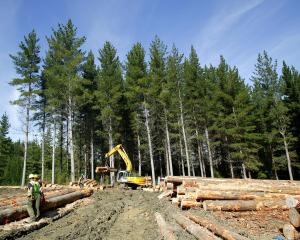Otago and Southland forest owners are expected to reap the benefits of China's demand for logs this year, in the face of record prices and following last year's 50% boost in overall log exports.
However, the forest owners' boon is a sawmillers' bane and millers are finding it increasingly difficult to maintain profit margins from the more expensive logs.
For the fourth year, Port Otago is targeting more than 700,000cu m of logs across its wharves, with 40 to 50 ship visits, and is ahead of budget. Bluff's South Port moved a record 195,000 tonnes of logs during the past six months.
While the forestry sector's fortunes are cyclical, China's ongoing demand and the lack of competition from Russia, Canada and United States, appear set to provide New Zealand growers with a relatively stable market in the short to medium term.
Southern Wood Council chairman Grant Dodson, who is also chief executive of Dunedin City Council-owned City Forests, believes the present Chinese demand was not creating a ''bubble'', which in past years has resulted in boom, then bust, years for the sector.
''I don't believe it's a bubble. The news out of the markets is that we are not getting significant competition,'' Mr Dodson said.
Log prices, for a combination of unpruned grades, were at present about $103 a cu m, having risen from $88 a year ago, and $94 six months ago.
Winton-based Craigpine Timber, which exports about 90% of its sawn timber to Asian markets, is having to maintain a ''sinking lid'' policy on non-critical staff and is turning to technology to boost productivity.
Craigpine forestry manager Brett Armour said, when contacted, many southern mills were ''struggling with profitability''.
The milling sector had been hard hit during the past two to three years, and up to 10 ''medium sized mills'' around the country had ''gone under''.
While sawn timber prices were up, and demand from Auckland and Christchurch was ''really strong'' and Queenstown was ''improving'', the domestic prices did not match the 20%-25% increase in log prices.
He said Craigpine's profitability this financial year would be dependent on China, and whether sawn timber demand from the US picked up.
Mr Armour estimated most sawmillers in the South would not have broken even last year.
Mr Dodson said last year's New Zealand log exports of about 15 million tonnes was equivalent to ''one and a-half log ships daily'' of exports.
The ANZ commodity price index noted that forestry reached a new high in January, underpinned by a 20-year high in log prices, and two-year high for wood pulp.
Mr Dodson said Russian and Canadian exports were down, the United States was diverting more timber from export to domestic construction, while China was holding smaller log stockpiles.
Because of the ongoing demand and outlook of lack of competition, Mr Dodson said that in the medium term - three to five years - there could be a ''prolonged positive cycle''; albeit with some volatility.
''[However,] forestry is a commodity and the market continually balances on a knife-edge'', he cautioned.
City Forests' was about 10% ahead on its target of cutting 265,000cu m of timber this year, and Mr Dodson emphasised that it was ''maintaining its commitment'' to local sawmills to deliver 45% of logs to them, while exporting 55%.
He was aware sawmillers were struggling under the pressure of high log prices.
Domestic prices for sawn timber had risen recently, but not as much as the 20% increase in log prices, Mr Dodson said.
''While it's tight for the domestic mills, most are able to survive, but they're not happy about the [log] price,'' Mr Dodson said.
Mr Armour said Craigpine has had to move from now-expensive low quality logs to higher quality, and get more logs from Otago and Southland.
Mr Dodson had a caution for southern forest owners, in that radiata in the south matured at 26 to 30 years old, but China was happy to pay the same price at present for forests in the unmatured 20 to 25-year-old bracket, largely because they were being used in China for industrial and packaging purposes.
''There is the temptation that the woodlot is there, and available now,'' Mr Dodson said. The demand was also creating pressure on the availability of harvesting crews, land transport and ships, and market newcomers ''may find it difficult'' to secure harvesting crews, Mr Dodson said.
Although City Forests was ''slightly ahead'' of its sustainable cutting levels, it was not cutting large volumes now in order to ''take a holiday'' with less harvesting in the future, he said.



